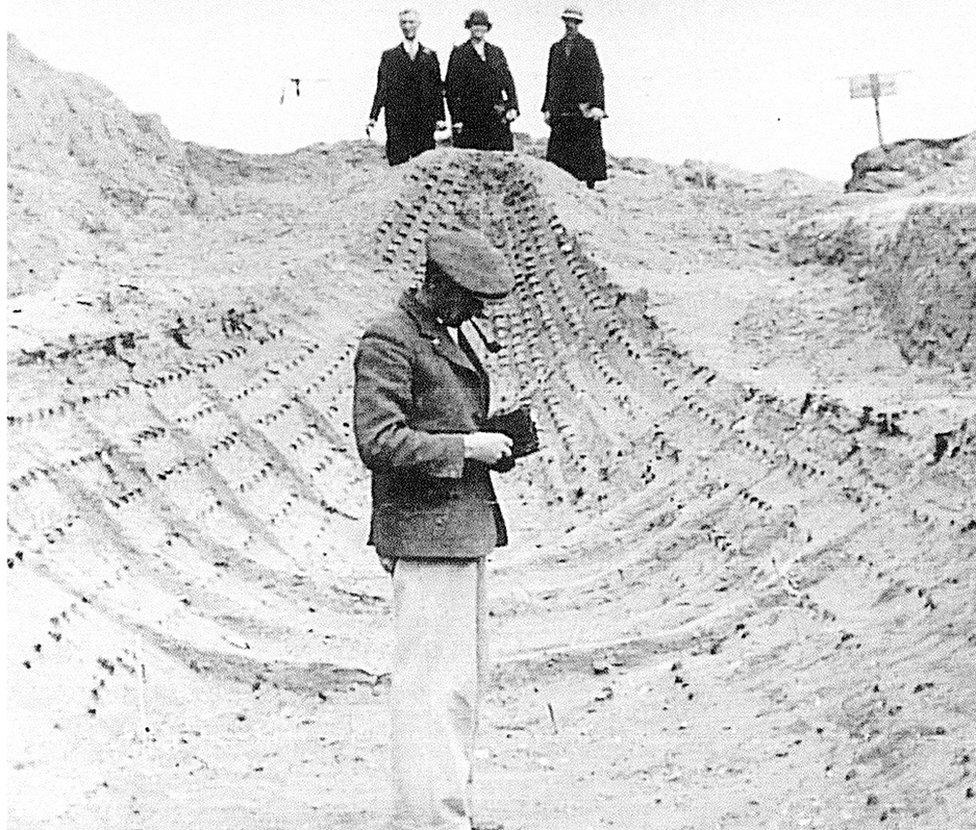The Dig: Will Gompertz reviews film starring Carey Mulligan & Ralph Fiennes ★★★★☆
- Published

It's late summer in England, 1939. The sight and sound of RAF planes flying overhead is an ominous reminder that war looms.
The prospect of conflict troubles sensitive Edith Pretty (Carey Mulligan), a young widow who owns a chunk of rural Suffolk on which large mounds of earth rise up in a flat field as if the land is infested by a gang of gargantuan moles.
The grassy knolls were the reason she and her late husband bought the property, they wanted to explore them together.
"Well, best laid plans…" she says a little too breezily.
Give or take the occasional botched prodding by Henry VIII and his mates, the mounds have been left alone for centuries.
Mrs Pretty has a "feeling" about one eminence in particular - the whopper in the middle. With her mustard-keen young son Robert (Archie Barnes) in tow, she invites local excavator Basil Brown (Ralph Fiennes) to see what he might unearth beneath the layers of mud.

Carey Mulligan as Edith Pretty and Ralph Fiennes as Basil Brown in The Dig
The self-taught, amateur archaeologist is a modest, quiet man who prefers to let his spade do the talking.
He's no fool, though.
So, when the softly-spoken, conspicuously wealthy Mrs Pretty plays financial hard-ball and offers him a derisory 35 shillings wage for his labours, he hops on his bike and cycles off into the sunset. She quickly ups the ante to £2, he relents, and together they survey the cluster of ancient hillocks. Then, and without much of a flourish, Basil whips out his trusty shovel and the dig begins.
"Is that why you wanted to dig, Mrs Pretty", he asks with more than a hint of condescension, "for buried treasure?"
Mrs Pretty takes a breath, and then politely and pointedly puts Basil Brown in his place. She had always had an interest in archaeology, she informs him. Her childhood home was built on a Cistercian convent no less.
"I helped my father excavate the apse", she announces.
"That speaks, dunnit. The past", he says
Mutual respect is established.
Mr Brown hasn't discovered anything underground yet, but he's already found a kindred spirit.

Fiennes is excellent as the taciturn excavator, an auto-didact with more knowledge than all those Cambridge types who put him down, and write him off as "difficult".
Mulligan is first class, too. It's always a pleasure to see her on screen or stage (she was terrific in the revival of David Hare's Skylight a while back, playing alongside an in-form Bill Nighy).
The emotional attachment between them builds as the no-frills Mr Brown takes on a father-figure role, teaching the excitable young Robert about the night sky.

Basil Brown showing the stars to an enthralled Robert (played by Archie Barnes), looked on by his mum Edith
Could there be a romance brewing between employee and employer?
She might be free, but he is married to the wise and supportive May (Monica Dolan).
Hmmm.
For two people passionate about archaeology, maybe they would be better off burying any bubbling feelings?
The Dig is promoted as being based on the true story of the great discovery of the Sutton Hoo Anglo-Saxon burial site, which it is - up to a point. Really, though, it is an investigation into the fleeting nature of life, the ever-present shadow of death, the joy and pain of love, and our deep, primal connection to the past and the soil from which we come and go.


The real Basil Brown on the site of what was seen as "one of the most important archaeological discoveries of all time"


The real Edith Pretty

It is low key and poetic.
A galaxy away from a Marvel Comic Universe GCI-fest, or an action-packed Bond movie, in which Fiennes currently plays the high-status M.

Ralph Fiennes as M with Daniel Craig as James Bond in Spectre
There are no baddies in this gently-paced film, just a gentlemanly tussle over ownership of the treasures between the imperious Charles Philips (Ken Stott) of the mighty British Museum, and the timid but conniving curators from Ipswich.
As relationships develop and characters are revealed, sub-plots emerge like buried artefacts.
The versatile Johnny Flynn plays the charming and daring would-be war hero Rory Lomax, who takes photos of the dig while awaiting his imminent military call up. A lot of his pics are of Mrs Peggy Piggott, played by the charismatic Lily James sporting a massive pair of specs and teacher's pet demeanour.

Johnny Flynn as Rory Lomax and Lily James as Peggy Piggott
The action, such as it is, takes place in a straightforward three-act structure, throughout which Australian director Simon Stone maintains a steady hand. Sweeping shots give way to intimate close-up pans, to conversations that are heard but not always seen - a neat device, the effectiveness of which diminishes every time it is employed.
Moira Buffini has done a good job adapting Preston's 2007 historical novel of the same name into a film script of depth and breadth, but the current habit for scriptwriters and filmmakers to end a movie with a written update is tiresome. Show not tell, and all that.
That aside, it is a thoroughly enjoyable film made with subtlety and sensitivity: a real tonic for these bleak winter days and nights. It lacks the emotional and intellectual heft and bite to make it an unmissable, classic movie, but I would happily watch it again, and again.
Recent reviews by Will Gompertz:
Follow Will Gompertz on Twitter, external
